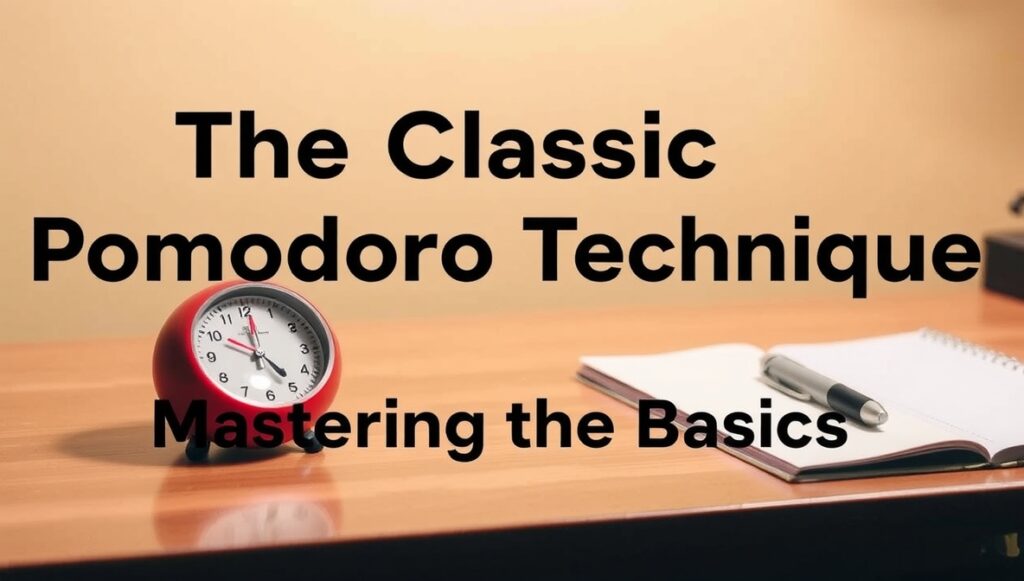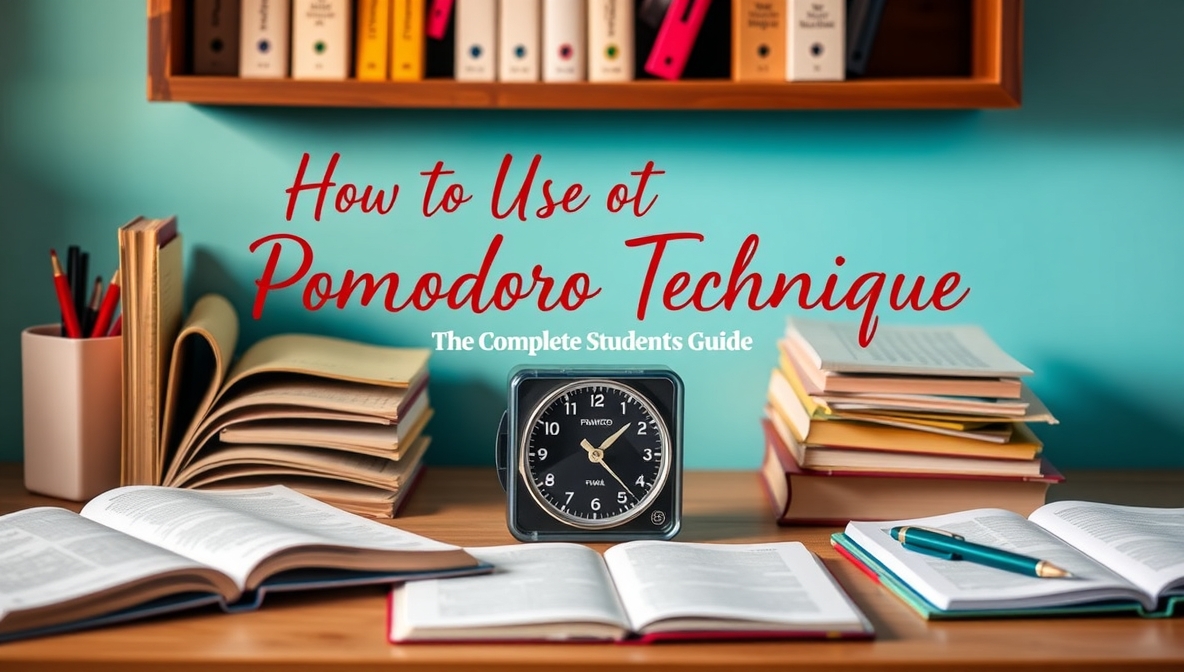In the late 1980s, a university student named Francesco Cirillo was struggling with focus and productivity. Feeling overwhelmed by his studies and unable to concentrate for extended periods, he grabbed a tomato-shaped kitchen timer (pomodoro is Italian for tomato) and committed to working in focused 25-minute intervals. This simple experiment evolved into one of the most effective time management and study techniques ever developed, now used by millions of students and professionals worldwide.

The Pomodoro Technique’s genius lies in its simplicity and its alignment with how our brains naturally function. By breaking work into manageable chunks and incorporating regular breaks, it addresses the fundamental challenges that plague modern studying: scattered attention, mental fatigue, procrastination, and the overwhelming nature of large academic tasks. For students drowning in coursework and struggling with focus in our distraction-rich world, the Pomodoro Technique offers a lifeline to more effective, less stressful, and ultimately more successful studying.
This comprehensive guide will teach you not just the basics of the Pomodoro Technique, but how to adapt, optimize, and master it for various study scenarios, subjects, and personal learning styles. You’ll discover advanced applications, troubleshooting strategies, and ways to integrate this powerful method into your broader academic success system.
Understanding the Science Behind Pomodoro
The Neuroscience of Focused Attention
The human brain’s attention system operates in predictable patterns that the Pomodoro Technique leverages brilliantly. Our prefrontal cortex—responsible for focus, decision-making, and self-control—has limited capacity and becomes depleted with sustained use. This phenomenon, known as “ego depletion” or “decision fatigue,” explains why maintaining focus becomes increasingly difficult during long study sessions.
The 90-120 Minute Ultradian Rhythm: Research has identified natural cycles of alertness that occur throughout the day, typically lasting 90-120 minutes. Within these cycles, we experience periods of high focus followed by natural lulls. The Pomodoro Technique works with these rhythms rather than against them, using breaks to reset attention before focus naturally declines.
Working Memory and Cognitive Load: Our working memory can only hold 4-7 pieces of information simultaneously. Long study sessions often overload this system, leading to decreased comprehension and retention. The Pomodoro Technique’s structured breaks allow working memory to consolidate information and reset for optimal performance.
Why Traditional Study Methods Fail
The Marathon Fallacy: Many students believe that longer study sessions automatically equal better learning. However, research consistently shows that sustained attention degrades significantly after 45-90 minutes without breaks. Students who attempt 4-hour marathon sessions often accomplish less than those using structured intervals.
Procrastination Psychology: Large, overwhelming tasks trigger our brain’s threat-detection system, leading to avoidance behaviors. The Pomodoro Technique transforms intimidating projects into manageable 25-minute commitments, reducing psychological resistance and making it easier to begin studying.
The Zeigarnik Effect: Our brains maintain mental tension around unfinished tasks, creating cognitive background noise that impairs focus on current activities. Pomodoro’s clear start and stop points help resolve this tension while ensuring regular progress toward completion.
The Classic Pomodoro Technique: Mastering the Basics
The Traditional Protocol
Step 1: Choose Your Task
- Select a specific study goal that can reasonably be accomplished in 25 minutes
- Write it down clearly (e.g., “Read pages 45-60 of biology textbook and take notes”)
- Avoid vague goals like “study chemistry” in favor of specific objectives

Step 2: Set the Timer
- Use a physical timer, smartphone app, or computer program
- Set for exactly 25 minutes
- The ticking sound of physical timers can provide helpful urgency cues
Step 3: Work with Complete Focus
- Begin studying immediately when the timer starts
- Resist all urges to check social media, answer messages, or multitask
- If distracting thoughts arise, quickly jot them down and return to the task
- Push through minor discomfort or boredom—the timer provides a finite endpoint
Step 4: Take the Break
- When the timer rings, stop immediately, even if you’re in the middle of something
- Take a 5-minute break away from your study materials
- Avoid mentally stimulating activities during breaks
- Move your body, hydrate, or practice brief relaxation
Step 5: Track Your Progress
- Mark each completed pomodoro (traditionally with an X or checkmark)
- After 4 pomodoros, take a longer break (15-30 minutes)
- Use longer breaks for more substantial rest and reflection
Essential Setup Requirements
Physical Environment:
- Clean, organized workspace free from distractions
- All necessary materials within arm’s reach
- Comfortable seating that promotes alertness
- Proper lighting to prevent eye strain and maintain energy
Digital Environment:
- Close all non-essential browser tabs and applications
- Use website blockers or focus apps if needed
- Keep phone in another room or in airplane mode
- Have backup timer methods in case primary fails
Mental Preparation:
- Choose study material appropriate for 25-minute intervals
- Have water and light snacks available to minimize interruptions
- Inform family or roommates about your study schedule
- Prepare a list of suitable break activities
Advanced Pomodoro Applications for Different Study Types
Subject-Specific Adaptations
Mathematics and Problem-Solving Subjects:
- Use pomodoros for working through specific problem sets
- Dedicate first few minutes to reviewing relevant formulas
- Use breaks to mentally process solution strategies
- Consider slightly longer intervals (30-35 minutes) for complex problems
Literature and Reading-Heavy Subjects:
- Set page or chapter goals rather than time-based objectives
- Use active reading techniques (note-taking, questioning) to maintain engagement
- Alternate between reading and analysis pomodoros
- Take breaks away from text to process and reflect on content
Memorization-Intensive Subjects (languages, anatomy, history):
- Combine pomodoros with spaced repetition systems
- Use breaks for physical movement to aid memory consolidation
- Alternate between new material and review sessions
- Employ multiple sensory inputs (visual, auditory, kinesthetic) within sessions
Creative and Essay Writing:
- Use pomodoros for different writing stages (brainstorming, outlining, drafting, editing)
- Allow flexibility in break timing if in flow state
- Use breaks for physical movement to stimulate creativity
- Consider longer sessions (45-60 minutes) for deep writing work
Modified Pomodoro Variations
The Ultradian Pomodoro (90-120 minutes work, 20-30 minutes break):
- Best for: Deep learning, complex problem-solving, research projects
- Requires: Well-developed focus skills and interesting material
- Benefits: Allows for deep immersion and flow states
- Risks: Mental fatigue if attention wanes mid-session
The Micro Pomodoro (10-15 minutes work, 2-5 minutes break):
- Best for: Difficult material, low motivation days, building momentum
- Benefits: Reduces resistance to starting, builds confidence
- Applications: Learning challenging new concepts, overcoming procrastination
- Progression: Can be extended as focus improves
The Power Hour (50 minutes work, 10 minutes break):
- Best for: University lecture alignment, extensive reading
- Benefits: Matches common class schedules, allows deeper engagement
- Considerations: Requires good baseline focus abilities
- Break activities: Brief walk, stretching, hydration
The Sprint Pomodoro (15 minutes work, 5 minutes break):
- Best for: Review sessions, flashcards, quick comprehension checks
- Benefits: High energy, prevents detailed procrastination
- Applications: Final exam preparation, motivation building
- Multiple cycles: 6-8 sprints can equal traditional pomodoro productivity
Optimizing Your Pomodoro Practice
Pre-Pomodoro Preparation Rituals
The Study Session Setup (5 minutes before starting):
- Clear and organize workspace
- Gather all necessary materials
- Set specific, achievable goals for the session
- Briefly review previous session’s work
- Choose appropriate break activities in advance
Mental Preparation Techniques:
- Take 3 deep breaths to center focus
- Remind yourself of the bigger picture goal
- Visualize successful completion of the session
- Set intention for quality engagement with material
Break Optimization Strategies
Physical Movement Breaks:
- Stand and stretch to improve circulation
- Take brief walks, preferably outdoors
- Do light exercises (jumping jacks, push-ups, yoga poses)
- Practice neck and shoulder rolls to release tension
Mental Reset Activities:
- Practice brief mindfulness or meditation
- Look out window or at distant objects (eye rest)
- Listen to calming music or nature sounds
- Practice gratitude or positive visualization
Avoid During Breaks:
- Social media or news (overstimulating and time-consuming)
- Engaging conversations (difficult to time-limit)
- Food preparation or complex tasks
- Activities requiring decision-making or problem-solving
Long Break Strategic Usage
After 4 Pomodoros (15-30 minute breaks):
- Reflect on progress and adjust goals if needed
- Take a proper meal or substantial snack
- Engage in moderate physical activity
- Process and organize notes from previous sessions
- Plan objectives for next pomodoro cycle
Weekly Long Break Planning:
- Review overall academic progress
- Assess pomodoro technique effectiveness
- Adjust timing or methods based on results
- Plan upcoming week’s study priorities
- Celebrate achievements and completed goals
Troubleshooting Common Pomodoro Problems
“I Can’t Stop When the Timer Rings”
This common issue, especially when you’re in a productive flow state, seems counterproductive but actually strengthens the technique’s effectiveness.
The Discipline Benefit: Stopping mid-task builds self-control and trust in the system. Your brain learns that breaks are temporary and work will resume.
The Zeigarnik Effect Advantage: Unfinished tasks remain active in memory, making it easier to resume after breaks with maintained momentum.
Practical Solutions:
- Jot down exactly where you stopped and next steps
- Trust that ideas will return after the break
- Remember that fatigue accumulates even when you don’t feel it
- Use the break to mentally process what you’ve learned
“I Keep Getting Distracted During Pomodoros”
Internal Distraction Management:
- Keep a “distraction log” beside your study materials
- Quickly write down intrusive thoughts without engaging with them
- Use the “noting” technique: acknowledge the distraction and return to work
- Practice mindfulness meditation to improve attention control

External Distraction Solutions:
- Use noise-canceling headphones or white noise
- Study in locations with fewer interruption sources
- Inform others about your pomodoro schedule
- Create physical barriers (closed door, “studying” sign)
“25 Minutes Feels Too Long/Short”
For Those Who Find 25 Minutes Too Long:
- Start with 15 or even 10-minute intervals
- Gradually increase duration as attention span improves
- Focus on completing the interval rather than productivity amount
- Use more engaging study methods (active recall, teaching concepts aloud)
For Those Who Find 25 Minutes Too Short:
- Complete the full pomodoro before extending
- Try 30-35 minute intervals with proportionally longer breaks
- Use traditional 25-minute sessions for routine tasks
- Reserve longer intervals for complex, engaging material
“I Forget to Take Breaks”
Systemic Solutions:
- Use apps with automatic break reminders
- Set separate break timers that are difficult to ignore
- Create break accountability with study partners
- Link breaks to physical needs (bathroom, water, stretching)
Mindset Shifts:
- View breaks as productivity enhancers, not time wasters
- Remember that breaks prevent the deeper fatigue requiring longer recovery
- Consider breaks as rewards for completed focused work
- Track how break-taking affects overall session quality
Integration with Other Study Techniques
Combining Pomodoro with Active Learning
Spaced Repetition Systems:
- Use individual pomodoros for flashcard review sessions
- Alternate between learning new cards and reviewing older ones
- Take breaks between different subject flashcard sets
- Track which pomodoro timing works best for retention

Active Recall Practice:
- Dedicate pomodoros specifically to self-testing
- Use breaks to briefly review difficult concepts
- Alternate between learning pomodoros and testing pomodoros
- Create recall practice questions during study pomodoros
Note-Taking and Summarization:
- Use one pomodoro for reading, next for note-taking
- Create summary documents during designated pomodoros
- Review and refine notes in separate pomodoro sessions
- Use breaks to mentally organize information hierarchies
Technology Integration
Recommended Pomodoro Apps:
- Forest: Gamifies focus with virtual tree growing
- Be Focused: Simple, customizable timer with tracking
- PomoDone: Integrates with task management systems
- Focus Keeper: Detailed statistics and customization options
Analog Tools:
- Traditional kitchen timers (provide urgency through ticking)
- Dedicated Pomodoro timers (avoid phone distractions)
- Physical notebooks for tracking progress
- Wall clocks for break time awareness
Productivity System Integration:
- Link pomodoros to specific tasks in digital planners
- Use pomodoro counts as progress metrics
- Integrate with calendar blocking for study scheduling
- Combine with habit-tracking apps for consistency building
Measuring Success and Making Adjustments
Key Performance Indicators
Quantitative Measures:
- Number of completed pomodoros per day/week
- Percentage of planned pomodoros actually completed
- Quality rating for focus during each session (1-10 scale)
- Academic performance correlation with pomodoro consistency
Qualitative Assessments:
- Subjective satisfaction with study sessions
- Reduced procrastination and increased study initiation
- Improved ability to estimate task duration
- Enhanced sense of control over academic workload
Progressive Skill Development
Beginner Phase (Weeks 1-2):
- Focus on completing 25-minute intervals consistently
- Build habit of taking scheduled breaks
- Experiment with break activities to find optimal renewal
- Track completion rate rather than productivity amount

Intermediate Phase (Weeks 3-8):
- Optimize session length for different subjects and tasks
- Develop efficient pre-session preparation routines
- Master distraction management during focused intervals
- Begin using pomodoro data for academic planning
Advanced Phase (Weeks 9+):
- Adapt technique fluidly based on material and energy levels
- Integrate with sophisticated productivity and learning systems
- Help others implement the technique effectively
- Use pomodoro patterns to understand personal productivity rhythms
Long-Term Academic Success with Pomodoro
Building Sustainable Study Habits
The Pomodoro Technique’s greatest benefit isn’t immediate productivity—it’s the development of sustainable study habits that support long-term academic success.
Habit Formation Benefits:
- Reduces the mental energy required to start studying
- Creates positive associations with focused work
- Builds confidence through consistent small achievements
- Develops realistic expectations about study duration and breaks
Stress Reduction Through Structure:
- Large projects become series of manageable pomodoros
- Regular breaks prevent burnout and mental fatigue
- Clear stopping points reduce guilt about taking time off
- Progress tracking provides motivation and direction
Beyond University: Lifelong Learning Applications
Students who master the Pomodoro Technique gain skills that extend far beyond academic settings:
Professional Development:
- Project management and deadline adherence
- Focused work in distraction-rich environments
- Realistic time estimation for complex tasks
- Sustainable work practices that prevent burnout
Personal Learning:
- Language acquisition and skill development
- Creative projects and hobby advancement
- Reading and self-education programs
- Health and fitness goal achievement
Conclusion: Your Path to Pomodoro Mastery
The Pomodoro Technique represents more than a time management tool—it’s a framework for developing the focused attention skills essential for academic and professional success in our increasingly distracted world. The technique’s power lies not in its complexity, but in its elegant simplicity and alignment with human cognitive patterns.
Start your Pomodoro journey with realistic expectations. Your first sessions may feel awkward, breaks may feel unnecessary, and distractions will still occur. This is normal and expected. The technique’s benefits compound over time as you develop focus skills, establish productive habits, and gain confidence in your ability to tackle challenging academic material.
Remember that the traditional 25-minute format is a starting point, not a rigid rule. As you gain experience, adapt the technique to match your subjects, energy levels, and learning style. The goal isn’t perfect adherence to a prescribed system, but the development of sustainable study practices that support your academic goals while maintaining your well-being.
Your investment in mastering the Pomodoro Technique will pay dividends throughout your academic career and beyond. The skills you develop—sustained attention, realistic planning, consistent work habits, and stress management—are increasingly valuable in our fast-paced, distraction-rich world.
Begin today with a single pomodoro. Choose a specific study task, set your timer for 25 minutes, and experience the focused productivity that has helped millions of students achieve their academic goals. Your future self will thank you for taking this first step toward more effective, less stressful, and ultimately more successful studying.



